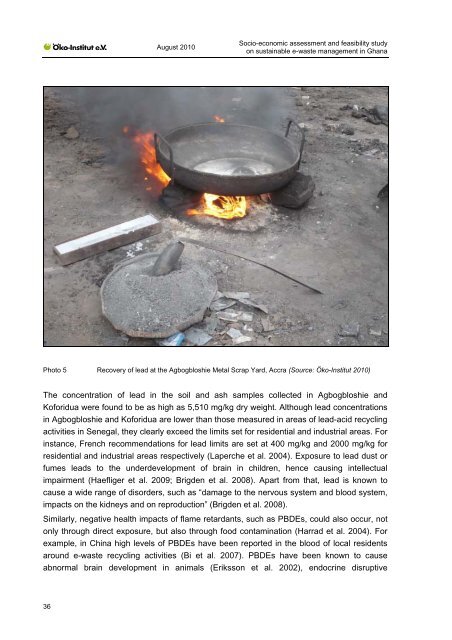Socio-economic assessment and feasibility study on - Öko-Institut eV
Socio-economic assessment and feasibility study on - Öko-Institut eV
Socio-economic assessment and feasibility study on - Öko-Institut eV
You also want an ePaper? Increase the reach of your titles
YUMPU automatically turns print PDFs into web optimized ePapers that Google loves.
36<br />
August 2010<br />
<str<strong>on</strong>g>Socio</str<strong>on</strong>g>-<str<strong>on</strong>g>ec<strong>on</strong>omic</str<strong>on</strong>g> <str<strong>on</strong>g>assessment</str<strong>on</strong>g> <str<strong>on</strong>g>and</str<strong>on</strong>g> <str<strong>on</strong>g>feasibility</str<strong>on</strong>g> <str<strong>on</strong>g>study</str<strong>on</strong>g><br />
<strong>on</strong> sustainable e-waste management in Ghana<br />
Photo 5 Recovery of lead at the Agbogbloshie Metal Scrap Yard, Accra (Source: Öko-<strong>Institut</strong> 2010)<br />
The c<strong>on</strong>centrati<strong>on</strong> of lead in the soil <str<strong>on</strong>g>and</str<strong>on</strong>g> ash samples collected in Agbogbloshie <str<strong>on</strong>g>and</str<strong>on</strong>g><br />
Koforidua were found to be as high as 5,510 mg/kg dry weight. Although lead c<strong>on</strong>centrati<strong>on</strong>s<br />
in Agbogbloshie <str<strong>on</strong>g>and</str<strong>on</strong>g> Koforidua are lower than those measured in areas of lead-acid recycling<br />
activities in Senegal, they clearly exceed the limits set for residential <str<strong>on</strong>g>and</str<strong>on</strong>g> industrial areas. For<br />
instance, French recommendati<strong>on</strong>s for lead limits are set at 400 mg/kg <str<strong>on</strong>g>and</str<strong>on</strong>g> 2000 mg/kg for<br />
residential <str<strong>on</strong>g>and</str<strong>on</strong>g> industrial areas respectively (Laperche et al. 2004). Exposure to lead dust or<br />
fumes leads to the underdevelopment of brain in children, hence causing intellectual<br />
impairment (Haefliger et al. 2009; Brigden et al. 2008). Apart from that, lead is known to<br />
cause a wide range of disorders, such as “damage to the nervous system <str<strong>on</strong>g>and</str<strong>on</strong>g> blood system,<br />
impacts <strong>on</strong> the kidneys <str<strong>on</strong>g>and</str<strong>on</strong>g> <strong>on</strong> reproducti<strong>on</strong>” (Brigden et al. 2008).<br />
Similarly, negative health impacts of flame retardants, such as PBDEs, could also occur, not<br />
<strong>on</strong>ly through direct exposure, but also through food c<strong>on</strong>taminati<strong>on</strong> (Harrad et al. 2004). For<br />
example, in China high levels of PBDEs have been reported in the blood of local residents<br />
around e-waste recycling activities (Bi et al. 2007). PBDEs have been known to cause<br />
abnormal brain development in animals (Erikss<strong>on</strong> et al. 2002), endocrine disruptive

















